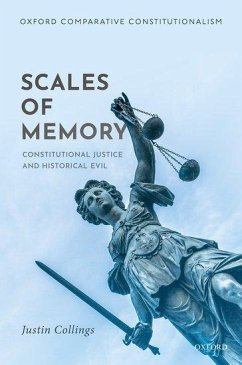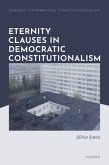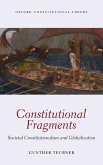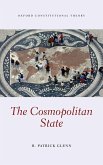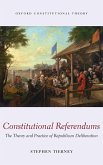Collings
SCALES OF MEMORY OCCL C
Collings
SCALES OF MEMORY OCCL C
- Gebundenes Buch
- Merkliste
- Auf die Merkliste
- Bewerten Bewerten
- Teilen
- Produkt teilen
- Produkterinnerung
- Produkterinnerung
This monograph explores how the constitutional courts in the United States, Germany, and South Africa have invoked slavery, Nazism, and apartheid - three historical evils - as an aid in constitutional interpretation. It examines how the memory of evil pasts moulds constitutional meaning in the contested present.
Andere Kunden interessierten sich auch für
![ETERNITY CLAUSES DEMOCRACT CONST OCCL C ETERNITY CLAUSES DEMOCRACT CONST OCCL C]() SuteuETERNITY CLAUSES DEMOCRACT CONST OCCL C115,99 €
SuteuETERNITY CLAUSES DEMOCRACT CONST OCCL C115,99 €![GLOBAL SOUTH & COMP CONST LAW OCCL C GLOBAL SOUTH & COMP CONST LAW OCCL C]() Dann Et AlGLOBAL SOUTH & COMP CONST LAW OCCL C128,99 €
Dann Et AlGLOBAL SOUTH & COMP CONST LAW OCCL C128,99 €![Sword and Scales Sword and Scales]() Martin LoughlinSword and Scales109,99 €
Martin LoughlinSword and Scales109,99 €![CONSTIT FRAGMENTS CONSTIT FRAGMENTS]() Gunther TeubnerCONSTIT FRAGMENTS137,99 €
Gunther TeubnerCONSTIT FRAGMENTS137,99 €![COSMOPOLITAN STATE OCON C COSMOPOLITAN STATE OCON C]() GlennCOSMOPOLITAN STATE OCON C129,99 €
GlennCOSMOPOLITAN STATE OCON C129,99 €![CONSTITUTIONAL REFERENDUMS OCON C CONSTITUTIONAL REFERENDUMS OCON C]() TierneyCONSTITUTIONAL REFERENDUMS OCON C160,99 €
TierneyCONSTITUTIONAL REFERENDUMS OCON C160,99 €![The West Virginia State Constitution The West Virginia State Constitution]() BastressThe West Virginia State Constitution178,99 €
BastressThe West Virginia State Constitution178,99 €-
-
-
This monograph explores how the constitutional courts in the United States, Germany, and South Africa have invoked slavery, Nazism, and apartheid - three historical evils - as an aid in constitutional interpretation. It examines how the memory of evil pasts moulds constitutional meaning in the contested present.
Produktdetails
- Produktdetails
- Verlag: ACADEMIC
- Seitenzahl: 366
- Erscheinungstermin: 5. Januar 2021
- Englisch
- Abmessung: 240mm x 161mm x 24mm
- Gewicht: 713g
- ISBN-13: 9780198858850
- ISBN-10: 019885885X
- Artikelnr.: 60327561
- Herstellerkennzeichnung
- Libri GmbH
- Europaallee 1
- 36244 Bad Hersfeld
- gpsr@libri.de
- Verlag: ACADEMIC
- Seitenzahl: 366
- Erscheinungstermin: 5. Januar 2021
- Englisch
- Abmessung: 240mm x 161mm x 24mm
- Gewicht: 713g
- ISBN-13: 9780198858850
- ISBN-10: 019885885X
- Artikelnr.: 60327561
- Herstellerkennzeichnung
- Libri GmbH
- Europaallee 1
- 36244 Bad Hersfeld
- gpsr@libri.de
Justin Collings is Professor of Law at the J. Reuben Clark Law School of Brigham Young University, where he has taught since 2013. He is the author of Democracy's Guardians: A History of the German Federal Constitutional Court, 1951-2001 (OUP, 2015). He holds both a PhD in History and a JD from Yale University and was a law clerk to the Honourable Guido Calabresi at the United States Court of Appeals for the Second Circuit.
I. Introduction: Constitutional Justice and Collective Memory
1: Introduction
2: Modes of Judicial Memory
3: The Modes and the Courts
4: Constitutional Memory in Comparative Perspective
5: Conclusion
PART ONE: SLAVERY
II. A Century of Lost Time: 1865-1954
1: Introduction: Memorial Day 1895
2: Mnemonic Gilded Age - After Appomattox: 1865-1896
3: After Plessy: 1896-1954
III. After Brown
1: Introduction
2: From Brown to the Civil Rights Act: 1954-1964
3: From the Civil Rights Act to Bakke: 1964-1978
4: From Bakke to Grutter: 1978-2003
5: Constitutional Memory on the Roberts Court
6: Conclusion
PART TWO: AFTER AUSCHWITZ
IV. After Hitler: 1951-1975
1: Introduction: 10 March 1965
2: Anti-Nazi Assertion and Parenthetical Restraint: 1949-1959
3: Memory Subdued, then Roused: 1959-1975
4: The Social-Liberal Coalition: 1969-1975
5: Conclusion
V. Forever in Hitler's Shadow? The Court Since 1975
1: Introduction: Constitutional Patriotism and the Pre-Constitutional Past
2: The Path to Permanence: 1975-1990
3: Republic of Memory: 1989 and Beyond
4: Conclusion: Generations of Judicial Memory
PART THREE: AFTER APARTHEID
VI. South Africa's First Constitutional Court: 1995-2005
1: Introduction: 10 May 1994
2: Epic Beginnings
3: Crime, Punishment, and the Mnemonics of Redemption
4: Bridge in the Background: The Presence of the Past
5: Spheres of Equality
6: Realms of Liberty
7: Realms of Positive Freedom: Socio-Economic Rights
8: Conclusion
VII. Chasing Rainbows: 2005-2020
1: Introduction: Rainbows End?
2: Continuities
3: Making National Memory
4: Memory and Power
5: Political Rights
6: Socio-Economic Rights
7: Conclusion: The Limits of Judicial Vergangenheitsbewältigung
VIII. Conclusion: Memory in the Balance
1: Constitutional Courts as Sites of Memory
2: Revisiting Modes and Models
1: Introduction
2: Modes of Judicial Memory
3: The Modes and the Courts
4: Constitutional Memory in Comparative Perspective
5: Conclusion
PART ONE: SLAVERY
II. A Century of Lost Time: 1865-1954
1: Introduction: Memorial Day 1895
2: Mnemonic Gilded Age - After Appomattox: 1865-1896
3: After Plessy: 1896-1954
III. After Brown
1: Introduction
2: From Brown to the Civil Rights Act: 1954-1964
3: From the Civil Rights Act to Bakke: 1964-1978
4: From Bakke to Grutter: 1978-2003
5: Constitutional Memory on the Roberts Court
6: Conclusion
PART TWO: AFTER AUSCHWITZ
IV. After Hitler: 1951-1975
1: Introduction: 10 March 1965
2: Anti-Nazi Assertion and Parenthetical Restraint: 1949-1959
3: Memory Subdued, then Roused: 1959-1975
4: The Social-Liberal Coalition: 1969-1975
5: Conclusion
V. Forever in Hitler's Shadow? The Court Since 1975
1: Introduction: Constitutional Patriotism and the Pre-Constitutional Past
2: The Path to Permanence: 1975-1990
3: Republic of Memory: 1989 and Beyond
4: Conclusion: Generations of Judicial Memory
PART THREE: AFTER APARTHEID
VI. South Africa's First Constitutional Court: 1995-2005
1: Introduction: 10 May 1994
2: Epic Beginnings
3: Crime, Punishment, and the Mnemonics of Redemption
4: Bridge in the Background: The Presence of the Past
5: Spheres of Equality
6: Realms of Liberty
7: Realms of Positive Freedom: Socio-Economic Rights
8: Conclusion
VII. Chasing Rainbows: 2005-2020
1: Introduction: Rainbows End?
2: Continuities
3: Making National Memory
4: Memory and Power
5: Political Rights
6: Socio-Economic Rights
7: Conclusion: The Limits of Judicial Vergangenheitsbewältigung
VIII. Conclusion: Memory in the Balance
1: Constitutional Courts as Sites of Memory
2: Revisiting Modes and Models
I. Introduction: Constitutional Justice and Collective Memory
1: Introduction
2: Modes of Judicial Memory
3: The Modes and the Courts
4: Constitutional Memory in Comparative Perspective
5: Conclusion
PART ONE: SLAVERY
II. A Century of Lost Time: 1865-1954
1: Introduction: Memorial Day 1895
2: Mnemonic Gilded Age - After Appomattox: 1865-1896
3: After Plessy: 1896-1954
III. After Brown
1: Introduction
2: From Brown to the Civil Rights Act: 1954-1964
3: From the Civil Rights Act to Bakke: 1964-1978
4: From Bakke to Grutter: 1978-2003
5: Constitutional Memory on the Roberts Court
6: Conclusion
PART TWO: AFTER AUSCHWITZ
IV. After Hitler: 1951-1975
1: Introduction: 10 March 1965
2: Anti-Nazi Assertion and Parenthetical Restraint: 1949-1959
3: Memory Subdued, then Roused: 1959-1975
4: The Social-Liberal Coalition: 1969-1975
5: Conclusion
V. Forever in Hitler's Shadow? The Court Since 1975
1: Introduction: Constitutional Patriotism and the Pre-Constitutional Past
2: The Path to Permanence: 1975-1990
3: Republic of Memory: 1989 and Beyond
4: Conclusion: Generations of Judicial Memory
PART THREE: AFTER APARTHEID
VI. South Africa's First Constitutional Court: 1995-2005
1: Introduction: 10 May 1994
2: Epic Beginnings
3: Crime, Punishment, and the Mnemonics of Redemption
4: Bridge in the Background: The Presence of the Past
5: Spheres of Equality
6: Realms of Liberty
7: Realms of Positive Freedom: Socio-Economic Rights
8: Conclusion
VII. Chasing Rainbows: 2005-2020
1: Introduction: Rainbows End?
2: Continuities
3: Making National Memory
4: Memory and Power
5: Political Rights
6: Socio-Economic Rights
7: Conclusion: The Limits of Judicial Vergangenheitsbewältigung
VIII. Conclusion: Memory in the Balance
1: Constitutional Courts as Sites of Memory
2: Revisiting Modes and Models
1: Introduction
2: Modes of Judicial Memory
3: The Modes and the Courts
4: Constitutional Memory in Comparative Perspective
5: Conclusion
PART ONE: SLAVERY
II. A Century of Lost Time: 1865-1954
1: Introduction: Memorial Day 1895
2: Mnemonic Gilded Age - After Appomattox: 1865-1896
3: After Plessy: 1896-1954
III. After Brown
1: Introduction
2: From Brown to the Civil Rights Act: 1954-1964
3: From the Civil Rights Act to Bakke: 1964-1978
4: From Bakke to Grutter: 1978-2003
5: Constitutional Memory on the Roberts Court
6: Conclusion
PART TWO: AFTER AUSCHWITZ
IV. After Hitler: 1951-1975
1: Introduction: 10 March 1965
2: Anti-Nazi Assertion and Parenthetical Restraint: 1949-1959
3: Memory Subdued, then Roused: 1959-1975
4: The Social-Liberal Coalition: 1969-1975
5: Conclusion
V. Forever in Hitler's Shadow? The Court Since 1975
1: Introduction: Constitutional Patriotism and the Pre-Constitutional Past
2: The Path to Permanence: 1975-1990
3: Republic of Memory: 1989 and Beyond
4: Conclusion: Generations of Judicial Memory
PART THREE: AFTER APARTHEID
VI. South Africa's First Constitutional Court: 1995-2005
1: Introduction: 10 May 1994
2: Epic Beginnings
3: Crime, Punishment, and the Mnemonics of Redemption
4: Bridge in the Background: The Presence of the Past
5: Spheres of Equality
6: Realms of Liberty
7: Realms of Positive Freedom: Socio-Economic Rights
8: Conclusion
VII. Chasing Rainbows: 2005-2020
1: Introduction: Rainbows End?
2: Continuities
3: Making National Memory
4: Memory and Power
5: Political Rights
6: Socio-Economic Rights
7: Conclusion: The Limits of Judicial Vergangenheitsbewältigung
VIII. Conclusion: Memory in the Balance
1: Constitutional Courts as Sites of Memory
2: Revisiting Modes and Models

